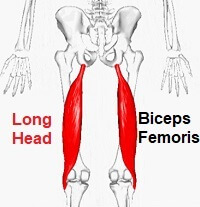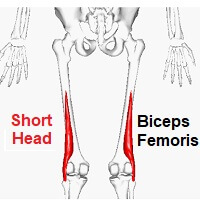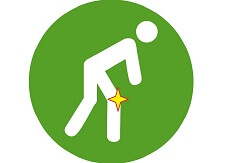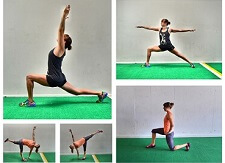- Home
- Knee Joint Anatomy
- Muscles
- Biceps Femoris
Biceps Femoris Muscle
Written By: Chloe Wilson, BSc(Hons) Physiotherapy
Reviewed by: KPE Medical Review Board
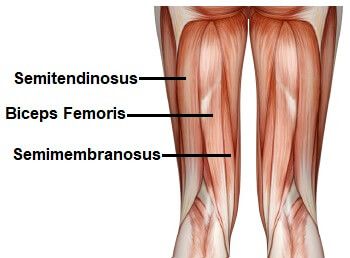
Biceps Femoris is one of the three hamstring muscles found on the back of the thigh.
Its name means:
- Biceps: 2 headed muscle
- Femoris: at the femur (thigh bone)
The two heads of biceps femoris originate quite far apart from each other - he "long head" arises from the pelvis, and the "short head" arises from the femur.
The muscle runs centrally down the back of the thigh to the knee and helps the other hamstring muscles to bend the knee.
Origin & Insertion
The long head of biceps femoris originates with the semitendinosus tendon, from the lower medial facet of the ischial tuberosity and the sacrotuberous ligament.
The two tendons descend together for a short distance before dividing into two individual muscles.
The long head of biceps femoris forms a fusiform muscle – a spindle shape with the muscle belly being wider than the origin and insertion.
It runs downwards and laterally (from the inner to outer side of the leg) across the back of the thigh, on top of the sciatic nerve. As it nears the knee it narrows and is joined underneath by the short head of biceps.
The short head of biceps femoris attaches to the lower half of the lateral lip of the linea aspera, just below the insertion of gluteus maximus, and extends down onto the upper half of the supracondylar line of the femur, with some fibres arising from the intermuscular septum.
It runs underneath the long head of biceps and the two parts of the muscle join forming one tendon in the distal thigh.
Having joined together, just before its attachment to the fibular head, the biceps femoris tendon splits into three.
- Some fibres join to the fibular/lateral collateral ligament
- Some attach on to the lateral tibial condyle
- The rest attach to the back of the lateral intermuscular septum.
Function of Biceps Femoris
The biceps femoris muscle has a number of different actions and functions:
- Knee Flexion: The primary function of both parts of the biceps femoris muscle is to help to bend the knee
- Hip Extension: The long head of biceps femoris works with the other hamstring muscles to extend the hip joint, particularly when rising up from a bent position e.g. straightening up after having bent forwards to put on shoes
- Trunk Flexion: The hamstrings also control the movement when you bend forwards at the trunk, working eccentrically, where the muscle lengthens rather than shortening.
- Leg Rotation: The long head of biceps rotates the leg laterally when the knee is semi-flexed, and the short head of biceps rotates the thigh and pelvis medially when the foot is fixed/planted
- Walking: The hamstrings also work to control the forward motion of the tibia during the swing phase of walking, preventing the knee from snapping back into extension
- Running: Biceps femoris (and the other hamstring muscles) is commonly injured in sprinters, as it works particularly hard in the push off and initial acceleration phase of sprinting - see Knee Pain From Running
Problems in the biceps femoris muscle often cause pain behind the knee.
Exercises For Biceps Femoris
Strengthening and stretching the biceps femoris muscle can help to improve knee function and reduce the risk of knee injuries. Check out the following articles:
- Hamstring Stretches: Check if your hamstrings are tight and find out the best ways to stretch biceps femoris
- Hamstring Strengthening Exercises: Start strengthening those hamstrings today from the comfort of you own home
Common Problems
Common problems that can affect the biceps femoris muscle include:
- Muscle Tightness: shortening of the biceps femoris muscle can limit both hip and knee movement and increase the risk of hamstring injuries
- Muscle Weakness: lack of strength or endurance in the muscle
- Muscle Strain: overstretching or overloading biceps femoris can result in a pulled hamstring
- Tendonitis: repetitive friction or overuse can result in hamstring tendonitis
Summary
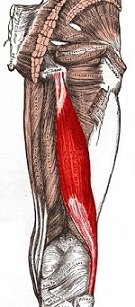
Muscle Group: Biceps Femoris is one of the three hamstrings muscles on the back of the thigh
Action: Knee flexion, knee rotation, hip extension
Origin: Two heads – long head from the lower medial facet on the ischial tuberosity, the short head from the lower half of the lateral lip of the linea aspera
Insertion: Head of fibula, fibula collateral ligament, lateral tibial condyle and lateral intermuscular septum
Nerve Supply: Long Head – tibial branch of the sciatic nerve. Short Head – common peroneal nerve (both L5, S1, S2)
Special Functions: Straightening the back from a bent position, controls the pelvis in standing, controls the knee as it swings forwards when walking
Other Knee Muscles
Page Last Updated: 23/06/23
Next Review Due: 23/06/25
